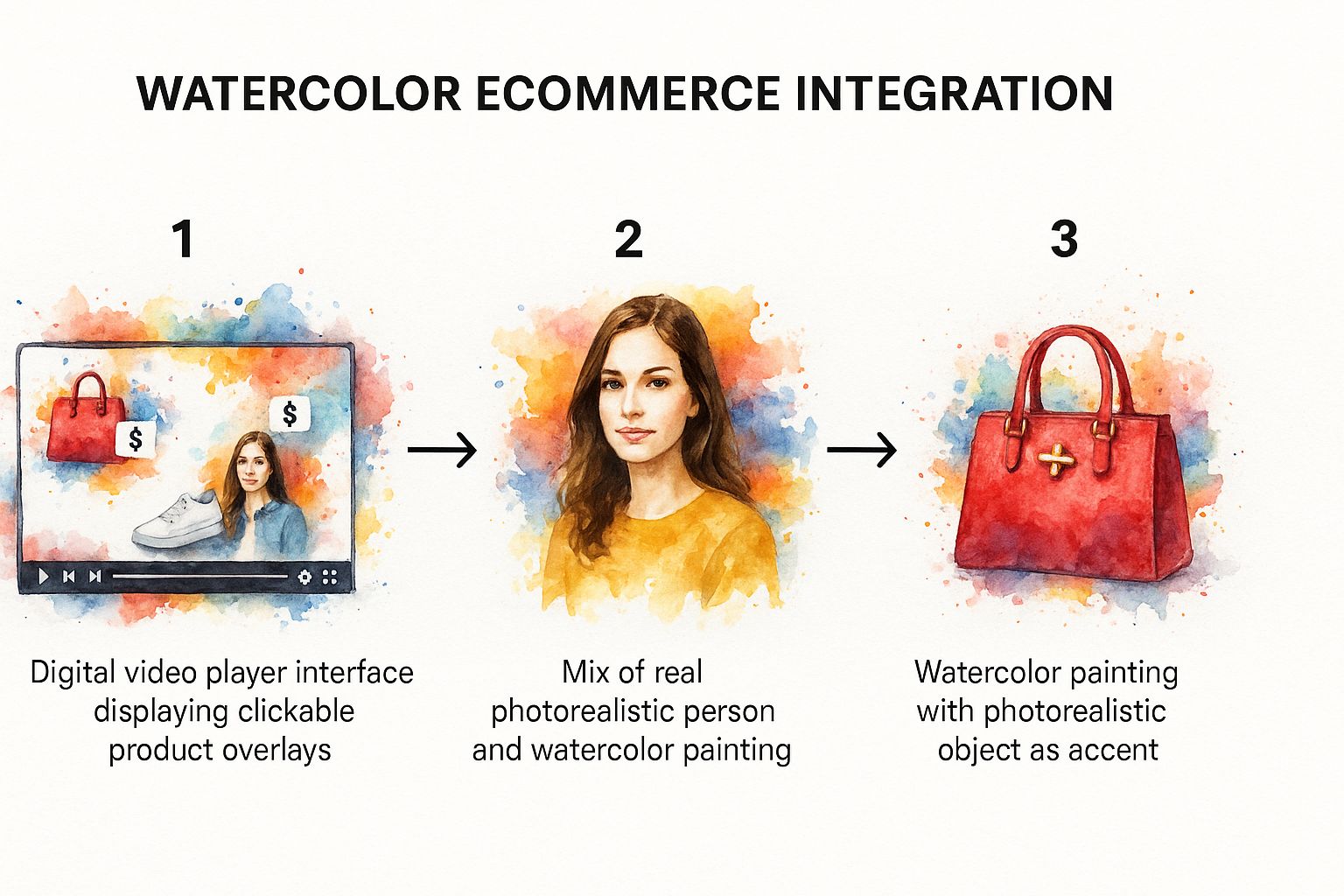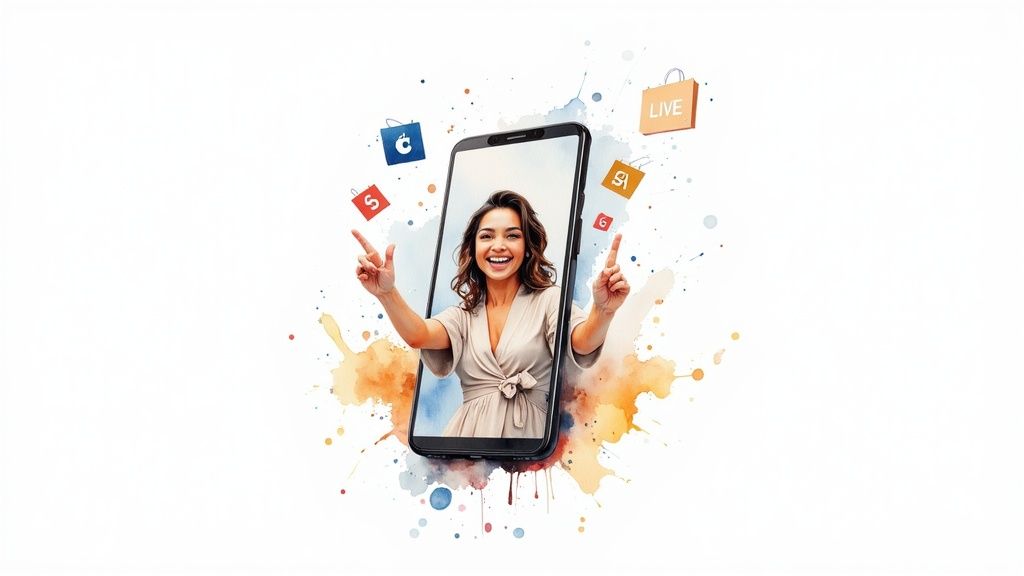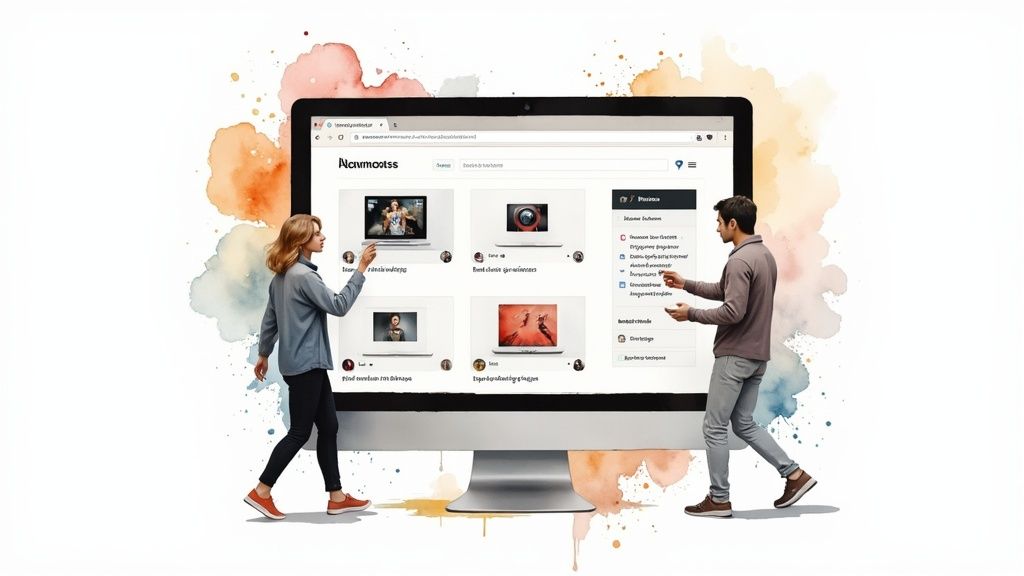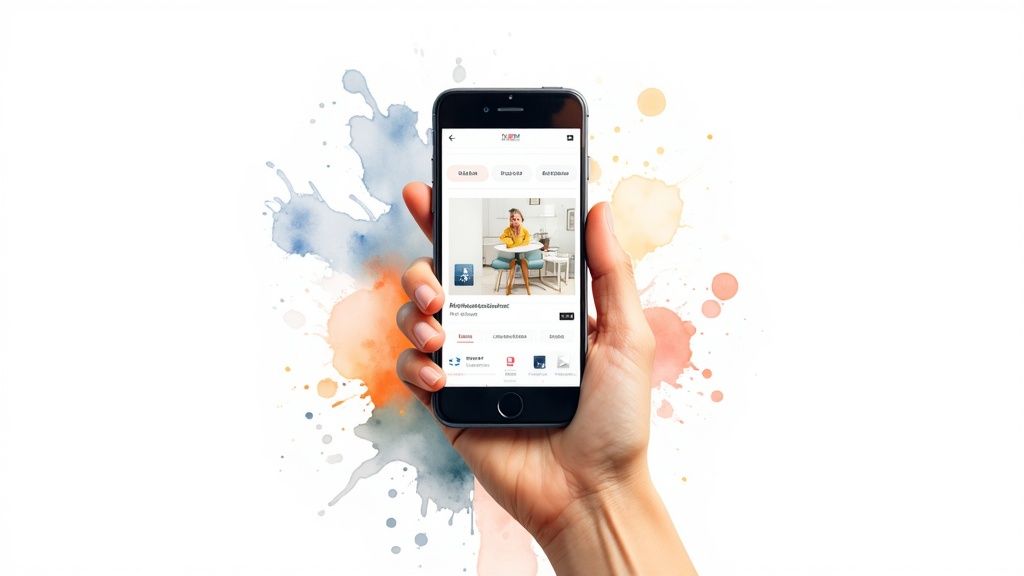Discover how a shoppable video platform can transform e-commerce. This guide covers how they work, key benefits, and how to create videos that drive sales.
In This Article
Subscribe to our newsletter
A shoppable video platform is a technology that turns regular videos into clickable, interactive shopping experiences. It closes the gap between entertainment and e-commerce, letting people buy products directly from the video they're watching.
The Bridge Between Watching and Buying
Imagine your best product videos weren't just ads, but dynamic, digital storefronts. A shoppable video platform is the engine that makes this a reality, blending the immersive pull of video with the instant satisfaction of online shopping.
Think of it as a digital personal shopper. It guides viewers from the moment of inspiration to the point of purchase, all without ever having to open a new tab or leave the video player. This tech is quickly becoming essential for brands that want to shorten the sales journey and build a real connection with their audience. Instead of just telling customers about a product, you can show them—and then let them act on that interest immediately.
From Passive Views to Active Purchases
The main job of a shoppable video platform is to add an interactive layer on top of your video content. This isn't about slapping a "buy now" button at the end of a clip. It's about making the video itself the point of sale.
Here’s how it completely changes the game for the user:
- Seamless Integration: Products are tagged right in the video. A viewer can click on a specific item—like a handbag in a fashion film or a blender in a cooking tutorial—to see details and pop it into their cart.
- Reduced Friction: By cutting out the need to search for a product on a separate website, these platforms drastically simplify the buying journey. That convenience is a huge factor in boosting conversion rates.
- Enhanced Engagement: Interactivity just plain keeps viewers more engaged. When they know they can interact with the items on screen, they pay closer attention. A passive viewing session becomes an active exploration.
The idea is simple but incredibly powerful: a shoppable video platform closes the gap between seeing something and wanting it. It turns a viewer from a spectator into a participant, shrinking the sales funnel from several steps down to a single click.
To get a clearer picture, let's break down the key components that make these platforms work.
Core Features of a Shoppable Video Platform
This table summarizes the essential functionalities that define a shoppable video platform, helping you quickly grasp its core capabilities.
| Feature | Description | Primary Benefit |
|---|---|---|
| Video Hotspots/Tagging | Allows creators to place clickable, interactive points on specific products or items within the video frame. | Makes products discoverable and shoppable at the exact moment of interest. |
| In-Video Product Cards | When a hotspot is clicked, a pop-up card appears with product details, pricing, and an "Add to Cart" button. | Provides immediate information and a direct path to purchase without leaving the video. |
| Integrated Cart & Checkout | Viewers can add multiple items to a cart and complete their purchase, all from within the video player interface. | Creates a seamless, frictionless shopping experience that boosts conversion rates. |
| Customizable Player | The look and feel of the video player, hotspots, and product cards can be customized to match brand aesthetics. | Maintains brand consistency and delivers a cohesive user experience. |
| Performance Analytics | Tracks key metrics like click-through rates, engagement, add-to-cart actions, and sales conversions. | Offers data-driven insights to optimize video content and sales strategy. |
These features work together to create an experience that feels both natural and transactional, which is a rare but potent combination.
A Rapidly Expanding Market
The move toward interactive content isn't just a fleeting trend; it's a major market shift. The global shoppable video platform market was valued at $3.2 billion in 2024 and is on track to hit $12.5 billion by 2033.
This incredible growth shows how quickly brands are realizing the value of turning their content directly into commerce. You can find more insights about this growing market on marketresearchintellect.com.
This technology is more than just a neat trick; it represents a fundamental change in how people interact with brands online. By making video content transactional, a shoppable video platform offers a direct, engaging, and incredibly effective way to drive sales and build a loyal customer base in a crowded digital world.
How a Shoppable Video Platform Actually Works
To really get what makes a shoppable video platform so powerful, you need to look under the hood. The magic isn't just about sticking a button on a video; it’s a sophisticated, elegant process that turns someone just watching into someone actively shopping. Think about following a single product from the moment it appears on screen all the way to a customer's shopping cart. It's a surprisingly seamless blend of video technology and e-commerce.
At its heart, the platform is a bridge. It connects your video files to your product catalog, creating an interactive layer that sits right on top of the video player. This all kicks off with the most important step: tagging.
This infographic breaks down the journey, showing how a product goes from being just another item in a video to a clickable, buyable thing in a matter of seconds.

As you can see, the platform gets rid of the friction between seeing something you want and actually buying it. It creates a straight line to purchase, and because the whole thing happens in one place, it works beautifully.
The Three Pillars of Functionality
The entire system rests on three core pillars working in harmony: product tagging, interactive overlay generation, and e-commerce integration. Each piece of this puzzle is critical for creating the kind of smooth, instant experience that modern shoppers now expect.
Let's break down how each one plays its part.
First up is product tagging. This is the foundation. It’s where you, the creator, pinpoint specific products within your video's timeline. You can think of it like dropping a digital anchor on each item you want to sell.
For example, say an influencer is unboxing a new pair of headphones at the 30-second mark. Using the platform's interface, you'd "tag" those headphones at that exact moment. This tag doesn't just mark the spot; it links the visual item to its product data—name, price, SKU, you name it—pulled straight from your product catalog.
A shoppable video platform essentially maps your product inventory onto your video content. Every frame becomes a potential point of sale, turning the video itself into a dynamic and browsable catalog. This creates a powerful connection between visual storytelling and transactional capability.
Generating Interactive Hotspots and Overlays
With a product tagged, the platform gets to work creating the interactive elements viewers will actually click on. These are often called hotspots or clickable overlays. As someone watches the video, these hotspots appear on the tagged products, signaling that they’re available for purchase.
When a viewer clicks a hotspot, it usually triggers an overlay—a little pop-up card that shows key product info without ever pausing the video. This card typically includes:
- Product Image: A clean, high-res shot of the item.
- Product Name and Price: The essential details, clear and simple.
- A Brief Description: Key selling points or materials.
- An "Add to Cart" Button: The all-important call to action for an immediate purchase.
This design is deliberate. It delivers all the necessary information right at the peak moment of interest, capitalizing on the impulse created by the video.
Seamless E-commerce Integration
The final piece of the puzzle is the platform's ability to talk directly to your e-commerce system, whether it’s Shopify, Magento, or BigCommerce. This e-commerce integration is absolutely vital for a frictionless checkout and for keeping your inventory straight.
When a customer clicks "Add to Cart" from the video overlay, the shoppable video platform zips that information directly to your store's backend. The item appears in their cart just as if they were browsing your main website. This ensures your inventory levels are always up-to-date in real-time, so you never accidentally sell an out-of-stock product.
On top of that, some of the more advanced platforms are now using AI for automated product recognition. This tech can actually scan your video, identify products on its own, and suggest the right tags. For brands with huge catalogs, this AI-powered approach is a game-changer, slashing manual work and helping you scale up your video commerce efforts much, much faster.
Key Benefits for E-commerce Brands
Bringing shoppable video into your e-commerce strategy is about so much more than adding a cool new feature. It's a direct, powerful way to tackle core business goals by turning passive viewers into active, paying customers. The benefits ripple out, touching everything from your sales cycle to how you understand what your audience truly wants.
When you embed commerce directly into compelling video, you meet customers at the peak of their inspiration. This creates a shopping experience that feels more natural, more satisfying, and—ultimately—more profitable. It just makes sense for how people consume media today.
Shortens the Sales Funnel Dramatically
Think about the classic e-commerce journey. A customer sees your product in a video. They open a new tab, search for your store, navigate to the product page, and then finally add it to their cart. Every single one of those steps is a potential exit ramp where they can get distracted or lose interest.
A shoppable video platform completely demolishes that clunky process. When a viewer sees an item they love, they can pull up details and add it to their cart without ever leaving the video player. That immediacy is a total game-changer.
By removing the barriers between inspiration and action, you essentially eliminate the middle of the sales funnel. The path from "I want that" to "I bought that" becomes a straight line, which is a powerful driver of impulse purchases and higher conversion rates.
This seamless experience respects your customer's time and attention. You're capitalizing on that "aha!" moment of peak interest before it has a chance to fade. The shorter the journey, the less room there is for second-guessing or abandoning a cart.
Boosts Conversions and Average Order Value
When you make buying something that easy, higher conversion rates are a natural result. The power to purchase at the exact moment of discovery is a massive advantage, and it's a trend that’s exploding across major markets.
For example, shoppable video is becoming a staple in the US, UK, and Europe. By 2025, adoption in these regions has soared, with some platforms seeing conversion rates hit as high as 12%. This data shows a clear shift in consumer preference—people want to shop this way.
But it's not just about converting more sales; these platforms are masters at increasing Average Order Value (AOV). Think about these common scenarios:
- Upselling: A video tutorial on your flagship coffee maker can feature a clickable hotspot for a premium grinder, nudging customers toward a higher-value purchase.
- Cross-selling: A fashion lookbook video lets viewers shop an entire outfit. Someone who came for a sweater might just add the tagged jeans and shoes to their cart, too.
- Product Bundles: A cooking video can present all the necessary ingredients and tools as a convenient, one-click bundle.
This capability turns a single product view into a chance to showcase a curated collection, organically encouraging customers to add more to their cart. To go even deeper on this, check out our guide on video marketing for e-commerce for more proven strategies.
Provides Invaluable Consumer Insights
Maybe one of the most underrated benefits is the sheer wealth of data you get. Standard video analytics might tell you about views and watch time, but interactive video metrics give you a direct window into your customers' intent and what products are catching their eye.
Shoppable video platforms are a major evolution from traditional e-commerce video ads because they make the experience interactive. The data you can gather is far more specific and immediately useful.
You can track detailed performance metrics like:
- Which specific products get the most clicks.
- The exact point in a video where viewers are most engaged.
- The click-through rate of different interactive hotspots.
- Which items are most frequently added to the cart directly from a video.
This information is pure gold for your marketing and product teams. If a certain product gets a ton of clicks but very few purchases, that could point to an issue with its price or product description. If a particular style in a lookbook video drives huge engagement, that's a clear signal to feature it more in your next campaign. This creates a powerful feedback loop, allowing you to fine-tune your entire strategy based on real-world behavior, not just guesswork.
Creative Formats for Shoppable Video Content

Not all shoppable videos are created equal. You could just slap some clickable overlays on a standard video, but that’s barely scratching the surface of what a real shoppable video platform can do. To actually grab attention and drive sales, you have to get creative. It’s all about matching the video format to your goals and creating an experience that feels authentic and valuable to your specific audience.
Thinking beyond a basic product showcase opens up a whole world of possibilities. The right format can do so much more than just sell; it can educate, entertain, build a community, and earn trust. It's about picking the right tool for the job—whether you need to create a burst of urgency or patiently walk someone through a product’s real-world value.
This matters more than ever, especially as this space explodes. The intersection of video and e-commerce is booming, with the shoppable video platform market on track to hit $5 billion by 2025. This growth is being pushed by social commerce and the rise of live shopping, so innovating your content isn’t optional anymore. You can dig deeper into these shoppable video market trends to see where things are headed.
Educational and How-To Videos
One of the most powerful formats out there is the shoppable tutorial or how-to video. This approach is brilliant because it demonstrates a product's true value in a practical, real-world setting. Picture a cooking show where you can instantly buy the exact pan the chef is using, or a DIY home repair video where every tool is just a click away.
These videos build incredible trust by being genuinely useful. The focus is on education, not a hard sell, making the purchase feel like a natural, helpful next step. This works wonders for products that really need a demonstration to shine, like tech gadgets, makeup, or specialized tools.
Key Goal: To build authority and demonstrate product value by solving a problem or teaching a skill, making the sale a byproduct of providing genuine help.
Immersive and Aspirational Formats
On the other end of the creative spectrum, you have formats built to inspire and forge a strong brand identity. These videos are less about the how and more about the feeling, tapping directly into a viewer's aspirations.
- Interactive Lookbooks: A favorite in the fashion world. These go way beyond static photos by showing how an outfit moves and looks in a real setting. Viewers can shop entire curated looks from the video, turning passive scrolling into an immersive styling session.
- Story-Driven Narratives: Think short films that weave your products into a compelling story. A brand might create a video about a weekend getaway, subtly featuring their shoppable luggage, apparel, and accessories to connect the products with a desirable lifestyle.
- Behind-the-Scenes Tours: Giving your audience a peek into your workshop or design process builds a powerful, personal connection. When you make the tools, materials, or featured creations shoppable, it adds an interactive layer that makes the experience even more authentic.
High-Energy Live Shopping Events
Live shopping is a format that absolutely thrives on urgency and community. Hosted in real-time, these events feel like a modern, interactive spin on the classic home shopping network. Typically, an influencer or brand host will showcase products, answer audience questions on the fly, and roll out limited-time deals.
This format is a powerhouse for a couple of key reasons. First, the live interaction creates a genuine sense of community and powerful social proof. Second, those limited-time offers trigger a strong sense of FOMO (fear of missing out), which drives immediate purchases. It’s the perfect formula for product launches, flash sales, and special events.
Choosing the Right Shoppable Video Platform
Picking the right shoppable video platform is a huge decision. It’s not just about adding a cool feature to your site; it’s a choice that will shape your entire interactive commerce strategy for years to come. With so many providers popping up, each with its own special mix of features and pricing, it's easy to get lost.
Think of it like choosing the foundation for a new house. A cheap or poorly matched option might look okay on day one, but it will cause major headaches down the line when you want to expand or add new features. A solid foundation supports your ambitions, while a weak one holds you back. Your platform choice works the exact same way.
Start by Assessing Your Own Business Needs
Before you even glance at a feature list, you need to look inward. What are you really trying to accomplish with shoppable video? A small boutique’s priorities will look very different from a massive enterprise's. One might need dead-simple social media integration, while the other demands iron-clad security, robust analytics, and global scalability.
Get your team together and ask these crucial questions:
- What's our number one goal? Are we trying to drive direct sales, bump up the average order value, or get deeper insights into what makes our customers tick?
- What's our actual budget? Be honest about what you can invest, looking at both the initial setup costs and the ongoing subscription fees.
- What technical muscle do we have? Do you have an in-house team ready to tackle complex setups, or do you need a simple, plug-and-play solution you can manage yourself?
Answering these questions first creates your own personal scorecard. It ensures your final decision is guided by your strategy, not just by a list of shiny new features.
Key Evaluation Criteria for Any Platform
Once you have your internal needs mapped out, you can begin the real work of comparing platforms. The best shoppable video platform for your brand is the one that aces the criteria that matter most to your business.
A huge piece of the puzzle is how well a new platform plays with your existing e-commerce stack. When considering your options, understanding the value of top systems integration services is key to making sure everything runs smoothly from day one. This kind of technical harmony is absolutely non-negotiable for a frictionless customer journey.
Choosing a platform is more than a technical decision; it's a strategic partnership. The right platform should feel like an extension of your team, providing the tools and support you need to turn your creative vision into measurable revenue.
To make this process a bit more concrete, here's a checklist to help you evaluate your options.
Platform Evaluation Checklist
This table breaks down the essential features you should be looking for as you compare different shoppable video platforms. Use it to cut through the marketing noise and focus on what truly matters for your business's success.
| Evaluation Criteria | What to Look For | Why It Matters for Your Business |
|---|---|---|
| Integration Capabilities | Pre-built connectors for your e-commerce platform (e.g., Shopify, Magento), CRM, and marketing automation tools. | Avoids costly custom development and ensures your systems work together to manage inventory and customer data accurately. |
| Analytics & Reporting | Granular data on video engagement, click-through rates, add-to-cart actions, and direct sales attribution. | Provides the insights needed to prove ROI and optimize your content strategy based on what actually drives purchases. |
| Customization Options | The ability to change the appearance of the video player, hotspots, and product cards to match your brand's visual identity. | Maintains a consistent and professional brand experience, which is vital for building customer trust and recognition. |
| Scalability & Performance | A platform built to handle high traffic volumes without compromising video load times or performance, especially during sales events. | Ensures a smooth user experience as your audience grows, preventing lost sales due to technical glitches or slow performance. |
| Pricing Model | Transparent, predictable pricing. Look for models that align with your growth, not punish it with excessive overage fees. | Allows for accurate budgeting and ensures the platform remains cost-effective as you scale your video commerce initiatives. |
By using a clear framework like this, you can confidently select a partner that aligns with your brand's unique needs and sets you up for long-term success.
Of course, once you have the platform, you need the content. To get a head start on that, you might want to explore our guide on the top 10 best AI video generators for 2025, which can help you create stunning visuals efficiently.
Creating Shoppable Videos That Actually Convert

Simply flipping the "shoppable" switch on a video won't magically open the sales floodgates. The real magic happens where great content meets smart strategy. To create videos that genuinely convert, you have to think like a viewer first and a seller second, turning a potential ad into a helpful, engaging experience.
The best shoppable videos almost never feel like ads. They weave products into a story or demonstration so seamlessly that the "buy" button feels like a convenient shortcut, not a pushy interruption. That authenticity is what separates a video that gets scrolled past from one that drives real results on your shoppable video platform.
Weave Products into a Narrative
Storytelling is your most powerful tool here. A video that just spits out a list of product features is forgettable. But a video that tells a story? That creates an emotional hook. It gives the product context, showing not just what it is, but what it can do for someone in their actual life.
Imagine a home decor brand. Instead of a sterile shot of a lamp against a white backdrop, you could show a short story of someone creating their perfect reading nook. As they fluff the pillows on a cozy chair and place the lamp just so, its features are shown in a natural, organic way. The shoppable hotspot that appears on the lamp is then a welcome shortcut for a viewer who’s feeling inspired by the whole vibe.
Your goal is to make the product a character in the story, not the entire plot. When a product serves the narrative, the call-to-action to purchase feels earned and helpful rather than intrusive.
This approach makes the shopping experience feel like a discovery, not a hard sell. It pulls viewers in, turning them into active participants in the story who are far more open to the products being featured.
Prioritize High-Quality Production
In the video world, quality is a direct reflection of your brand's credibility. Grainy footage, bad lighting, or muffled audio can make even the most amazing products feel cheap and untrustworthy. You don't need a Hollywood-level budget, but investing in good production is a non-negotiable for building trust.
Focus on these essentials:
- Crystal-Clear Visuals: Shoot in high definition. Viewers need to see the fine details, textures, and true colors of your products. This clarity is a huge factor in their decision to buy.
- Clean and Crisp Audio: Nothing makes a viewer click away faster than bad sound. A decent microphone is a must to ensure narration or dialogue is clear and free from distracting background noise.
- Stable and Engaging Camerawork: Shaky, jarring footage is a huge turn-off. Use a tripod for static shots and a gimbal for smooth, flowing movement. It instantly makes your video feel more polished and professional.
Beyond the creative side, you also need to make sure your videos are technically sound. You can learn more about optimizing images and videos for performance to ensure the user experience stays smooth.
Optimize for Mobile and Test Everything
Let's be real: the vast majority of people will watch your videos on their phones. This means you absolutely have to design for the small screen. Frame your shots tightly, use large and easy-to-read text, and make sure your interactive hotspots are big enough to be tapped easily with a thumb.
Finally, never assume you have it all figured out. A/B testing is your best friend for dialing in what works. Test different:
- Video Thumbnails: Which image grabs attention and makes people want to click play?
- CTA Placement: When is the perfect moment for a shoppable overlay to appear? Where on the screen does it get the most interaction?
- Hotspot Design: Do certain colors, icons, or animations get more taps?
This cycle of continuous testing and improvement will help you perfect your strategy over time. For more specific advice, check out our guide on how to create product demo videos that actually convert, which gets into the nitty-gritty of some of these techniques.
Common Questions About Shoppable Video
When brands start exploring shoppable video, a few practical questions always pop up. Getting straight answers is key to planning your strategy and, just as importantly, your budget. Let’s tackle some of the most common questions to help you get a handle on what it really takes to implement a shoppable video platform.
Can I Make My Existing Videos Shoppable?
Absolutely. In fact, this is one of the biggest perks. If you have a library of high-quality video content, you don’t need to start from scratch. A good shoppable video platform will let you upload your existing product demos, tutorials, or even old social clips and simply add an interactive layer over them.
This is a massive win for brands with a solid archive of video assets. You can instantly give your proven content a second life by adding shoppable hotspots and overlays, driving ROI without the time and expense of a new production. It’s also a fantastic way to quickly test which of your older videos get the most traction in an interactive format.
What Are the Typical Pricing Structures?
Pricing for a shoppable video platform isn't one-size-fits-all, but it usually falls into a few buckets. The best model for you will really depend on your scale and how you plan to use it.
- Subscription-Based (SaaS): This is the most common approach. You pay a set monthly or annual fee, with different tiers based on things like how many videos you have, total views, or the number of team members who need access.
- Performance-Based: Some platforms tie their fees to results. You might pay a small fee for every click or a percentage of the sales generated directly from the video.
- Hybrid Models: These are becoming more popular. They combine a flat subscription fee with performance-based charges, giving you a mix of predictable costs and paying for what you get.
The goal is to find a model that scales with you, not one that punishes your growth with surprise overage fees. Always look for transparent pricing.
What Kind of Analytics Can I Expect?
This is where things get exciting. The analytics you get from a shoppable video platform are worlds away from standard view counts and watch time. They offer deep, actionable insights into what your customers are actually interested in.
The data you receive is a direct window into your customers' purchase intent. You move from guessing what content works to knowing exactly which products and moments in a video are driving sales.
You can expect to track metrics that have a real impact on your bottom line, such as:
- Click-Through Rate (CTR): The percentage of viewers who clicked on a specific product hotspot.
- Add-to-Cart Rate: How many people added an item to their cart straight from the video player.
- Conversion Rate: The percentage of viewers who actually followed through and made a purchase.
- Product Engagement: Detailed data showing which products grabbed the most attention and interactions.
This level of detail empowers you to fine-tune your content, perfect your product placement, and finally prove the direct financial impact of your video strategy.
Ready to turn your content into a revenue stream? Aeon's powerful AI platform helps you create and scale high-quality video content effortlessly. Discover how Aeon can transform your publishing strategy today.


.jpg)